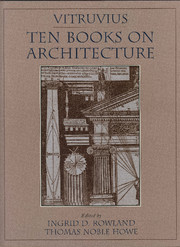Illustrator's Preface
Published online by Cambridge University Press: 18 December 2014
Summary
The illustrations of this project are designed with two principal purposes in mind: first, to investigate the possibility of a consistent design approach in Vitruvius; and second, to illustrate the relation of this approach to the broad principles of liberal knowledge that constitute approximately half of the material in the Ten Books.
The latter intent is more difficult to achieve within the scope of this project because a full commentary and illustration of the background knowledge of Vitruvius would almost constitute a complete panorama of Hellenistic liberal and technical knowledge. But any successful attempt to interpret Vitruvius must deal with the most salient feature of the Ten Books: that over half the material does not deal with architecture per se, but with other, supposedly supportive, fields of knowledge, like astronomy, geography, and natural philosophy. As Frank Brown has asserted, the mission of Vitruvius is to present architecture as a liberal art, based on a Hellenistic belief of the unity of knowledge. The Ten Books must be read therefore with at least a general knowledge of the numerous fields that Vitruvius touches upon, and also attitudes toward religion and cultural tradition.
The references to scientific knowledge in particular can appear digressive, fragmentary, and even bizarre to the modern reader (e.g., fish, being “dry,” can live in water, whereas humans, being “wet,” can live in air; 1.4.7). In fact, virtually every illustrative digression is a fragmentary reference to a large and coherent body of knowledge, of which Vitruvius is more or less a firm master. Our example refers to the Empedoclean chemical theory which asserts that bodies are stable when they are a tempered balance of the four elements (earth-air-fire-water) and unstable when there is excess or lack of one. They are stable when complemented by their environment and are corrupted when there is an excess or lack of an element in the conjunction of body and environment. Hence fish must be “dry” because, living in water, their lack is complemented by their environment, and they are corrupted in air because they then have an excess of air and a lack of water.
- Type
- Chapter
- Information
- Vitruvius: 'Ten Books on Architecture' , pp. xv - xviPublisher: Cambridge University PressPrint publication year: 1999



